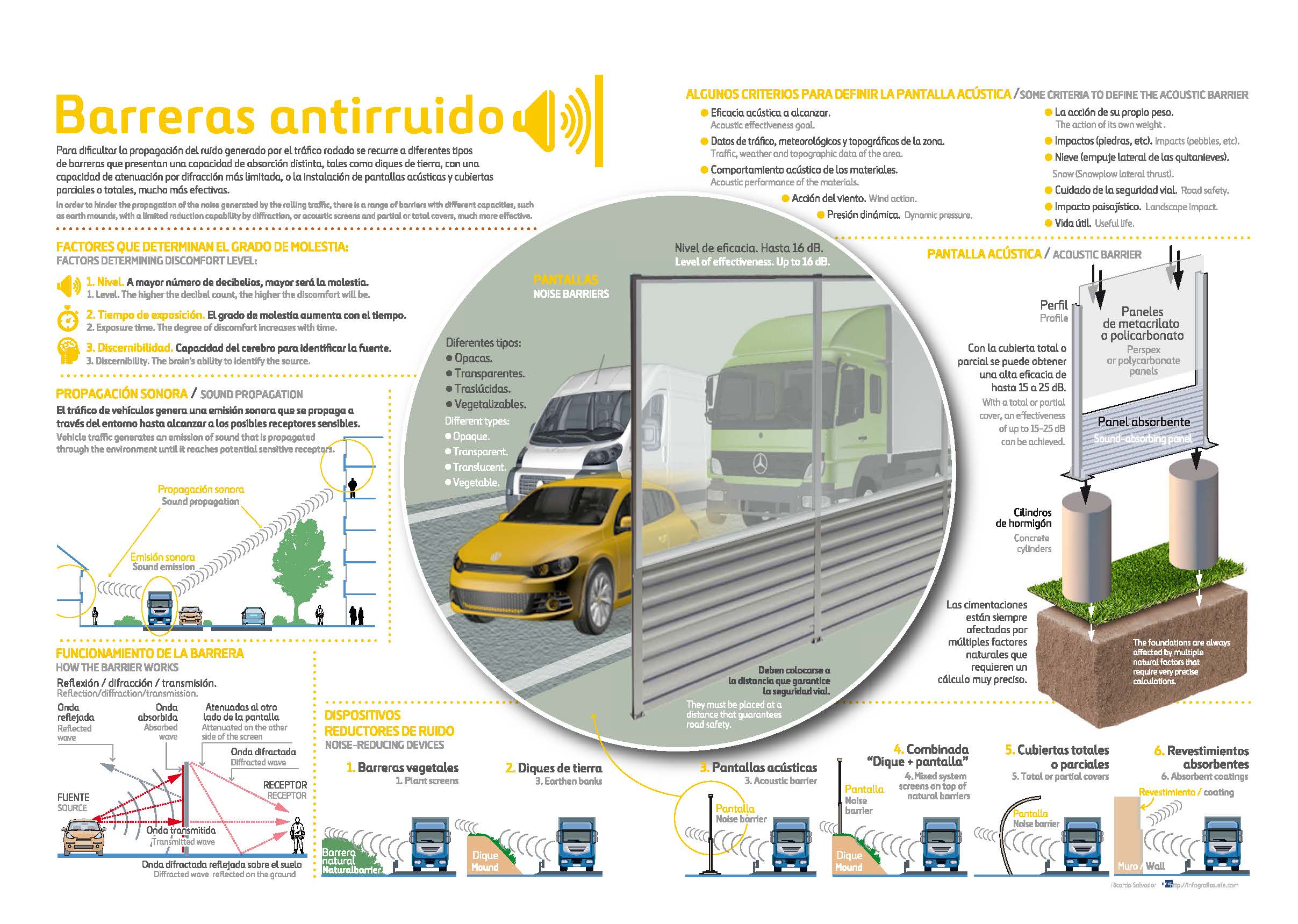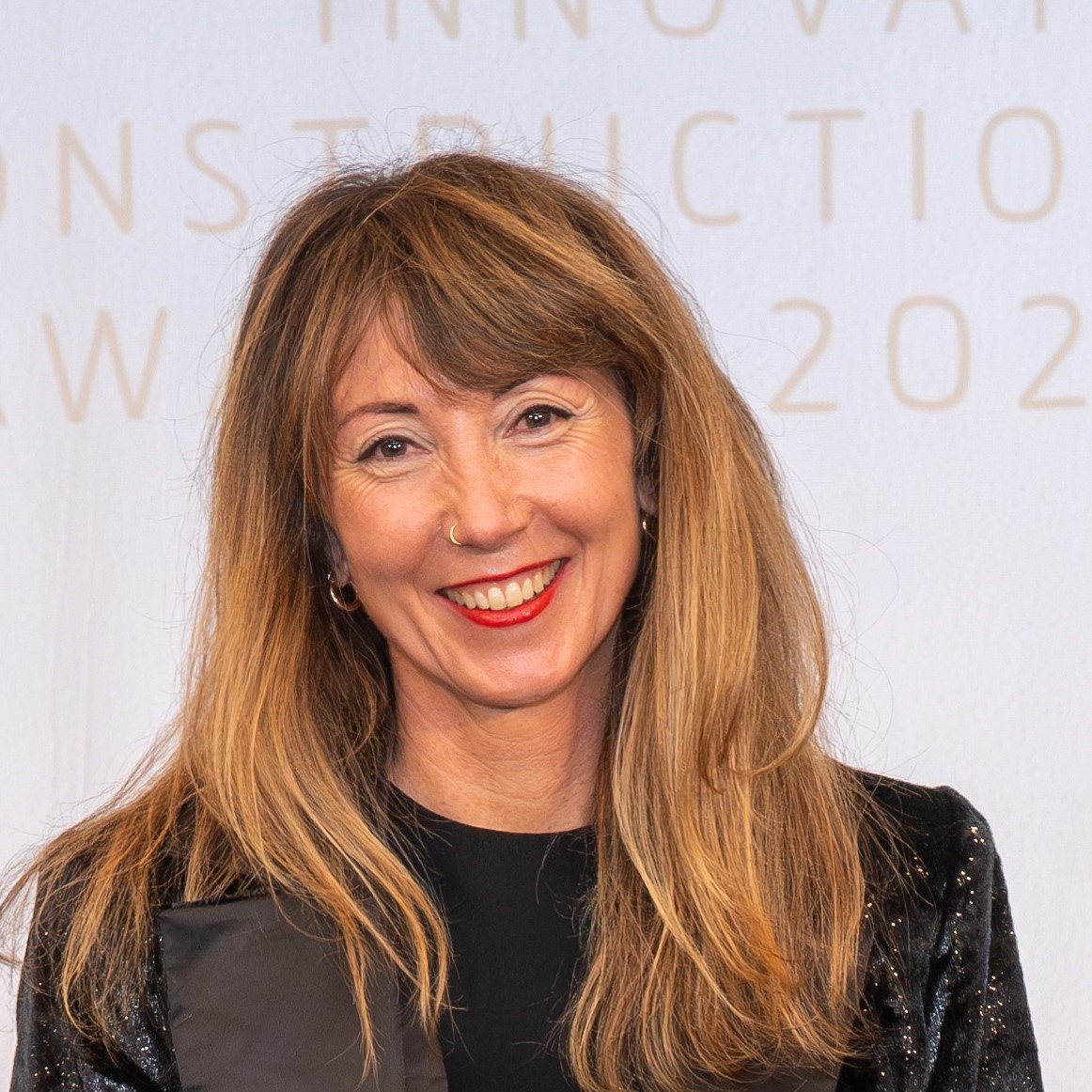The poor management of an infrastructure project’s acoustic impact can put paid to the work of years. Ferrovial is aware of the importance of establishing a strict noise mitigation policy and of the need to collaborate with authorities and neighbours on meeting their needs.
Insomnio, estrés, migrañas problemas cardiovasculares o de audición son algunas de las patologías que puede provocar la exposición continuada a una fuente de ruido. En la actividad de Ferrovial podemos identificar varias: maquinaria que emplea en sus proyectos de construcción, vehículos que circulan por las carreteras que gestiona, aviones que aterrizan y despegan de sus aeropuertos. El ruido y, concretamente, su mitigación se convierte así en un factor clave en el diseño, planificación y ejecución de los proyectos de la compañía. Reducir el impacto acústico no es solo un imperativo legal que, en el caso español, está definido tanto por la regulación europea (Directiva 2002/49/CE) como por la nacional (Ley 37/2003 y los reales decretos 1513/2005 y 1367/2007 que la desarrollan), sino también una cuestión de compromiso con la comunidad.
Esto lo sabe bien, Dámaso Alegre, Jefe del Departamento de Ingeniería Acústica de la Oficina Técnica de Ferrovial Agroman. “Una mala gestión del ruido generado por un proyecto puede dar al traste con años de trabajo”, sentencia. Alegre es una voz autorizada en el campo. Un vistazo a su currículum da fe de ello. En los últimos 28 años ha participado en más de 100 proyectos de construcción, informes técnicos y estudios de impacto acústico. Es miembro experto de los Comités Europeos de Normalización de dispositivos reductores de ruido para carreteras y Presidente Honorario y Vicepresidente Ejecutivo de la European Noise Barrier Federation.
La tarea de su equipo se centra en diseñar e implantar las medidas contra el ruido que se aplicarán durante la construcción y la operación de una infraestructura. Para definir esas medidas es necesario calcular el impacto acústico real de la infraestructura, atendiendo a aspectos como la potencia, la intensidad y la presión del sonido, la distancia entre la infraestructura y las zonas habitadas o la existencia de obstáculos naturales, entre otros. El método más común para representar gráficamente esos datos son los mapas de ruido, que pueden realizarse a través de simulaciones (lo que se aplica a proyectos por ejecutar) o de mediciones reales (más usado en infraestructuras en operación).
No obstante, como insiste Alegre, además de factores físicos hay que tener en cuenta otro que él ha bautizado como “discernibilidad”: la capacidad que el cerebro humano tiene de reconocer un sonido en un ambiente sonoro. “Pensemos en un grifo que gotea en la noche. A pesar de su bajo nivel sonoro puede impedir que conciliemos el sueño. Este es un ejemplo que demuestra que para conocer el impacto acústico real de uno de nuestros proyectos, es necesario conocer y atender las reclamaciones de los vecinos”, señala.

MINIMIZAR EL RUIDO DE LAS CARRETERAS
El ruido que genera una infraestructura se puede abordar de tres formas: actuando sobre el origen del sonido, actuando sobre la propagación del sonido o actuando sobre los receptores del ruido. Dentro de la primera alternativa, se incluiría la creación de pavimentos de baja sonoridad, que amortiguan el ruido generado por la rodadura de los neumáticos sobre la calzada. Ditecpesa, la filial especialista en pavimentos de Ferrovial Agroman, desarrolla mezclas capaces de reducir en hasta 3 a 7 decibelios ese ruido. La tercera haría referencia al aislamiento de las viviendas, a través de la instalación de ventanas y la construcción fachadas más efectivas. La segunda es la más común en los proyectos que desarrolla Ferrovial.
Abarca la instalación de obstáculos o elementos de absorción que limitan la propagación del sonido, desde la creación de diques de tierra, con una capacidad de atenuación por difracción más limitada, a la instalación de pantallas acústicas y cubiertas parciales o totales, mucho más efectivas.
Una vez implantadas las medidas, ofrecemos asistencia técnica continuada al proyecto, haciendo el seguimiento de los niveles sonoros generados y los mapas estratégicos de ruido requeridos por la Directiva Europea
Actualmente, las barreras de este tipo más utilizadas son las pantallas acústicas. Su diseño es complejo, ya que exige tomar decisiones sobre varios factores que determinarán su eficacia como su ubicación, medidas, estructura, materiales o cimentaciones. También hay que garantizar que la pantalla no afectará a la seguridad de los conductores que circulen por la vía y evitar un fuerte impacto visual sobre el paisaje. Todos estos factores dependen estrechamente de la vida útil que se quiera dar a la pantalla. Es aconsejable definir las características de la misma atendiendo al año horizonte de servicio, en el que las condiciones de tráfico pueden ser distintas a las que se registran en el año en que se instala.
“Nuestro trabajo no acaba aquí. Una vez implantadas las medidas, ofrecemos asistencia técnica al proyecto haciendo el seguimiento de los niveles sonoros generados y los mapas estratégicos de ruido requeridos por la Directiva Europea”, explica, Alegre. Uno de los proyectos que recuerda con cariño es el del aislamiento acústico de la Estación de Puerta de Atocha. “El Tribunal Superior de Justicia de la Comunidad de Madrid había dictado una sentencia que obligaba a respetar rigurosamente la Ordenanza Municipal sobre Ruidos y Vibraciones y confiaron en nosotros para diseñar una solución que cumpliese con ese imperativo legal. Tuvimos que introducir innovaciones tecnológicas en los programas de cálculo y realizamos las mediciones de ruido in situ con emisiones desde los andenes de la estación de 140 dBA mantenidas durante 1 minuto, una noche entre las 2 y las 3 de la madrugada”. En los 20 años que han pasado desde entonces, Ferrovial se ha mantenido a la vanguardia de soluciones para mitigar el ruido en todos sus proyectos y operaciones.
GESTIÓN DEL IMPACTO ACÚSTICO DE LOS AEROPUERTOS
Otra de las actividades de Ferrovial en la que mitigación de la contaminación acústica es una prioridad es la gestión aeroportuaria. Los cuatro aeropuertos en los que la compañía tiene participación desarrollan estrategias orientadas a reducir el ruido de los aviones en sus despegues y aterrizajes. El Aeropuerto de Heathrow ha elaborado un plan de acción específico que incluye iniciativas como el aislamiento acústico de edificios residenciales y equipamientos públicos (escuelas, hospitales, residencias, bibliotecas…), la reparación de daños causados por el ruido y la colaboración en el traslado de familias especialmente expuestas al ruido.
Recientemente ha aprobado el plan ‘Quieter Homes’ (‘Casas más Silenciosas’) que ofrecerá diferentes opciones de
aislamiento acústico gratuitas y a medida a hogares. Desde el punto de vista operativo, Heathrow se ha propuesto convertirse en uno de los primeros aeropuertos europeos en prescindir de los aviones más antiguos y ruidosos. Además, trabaja junto a NATS en reducir el tráfico nocturno, con el fin de mejorar el descanso de las poblaciones limítrofes, y las aerolíneas que operan en sus instalaciones están introduciendo tecnologías para mitigar la contaminación acústica de
sus aeronaves. Por su parte, el Aeropuerto de Glasgow abrirá una consulta pública en enero de 2018 sobre su Plan de Acción contra el Ruido, que establecerá cómo el aeropuerto gestionará y, en la medida de lo posible, reducirá los efectos del ruido generado por su actividad. Al mismo tiempo, mantiene un diálogo fluido y recurrente con las comunidades locales, a fin de entender y dar respuesta a sus preocupaciones al respecto. Por último, los aeropuertos de Southampton y Aberdeen cuentan con planes de acción que contemplan, la monitorización de los niveles de ruido, la introducción de rutas y horarios
preferentes y la colaboración con las aerolíneas para que empleen aeronaves menos ruidosas y más respetuosas con el medio ambiente.






